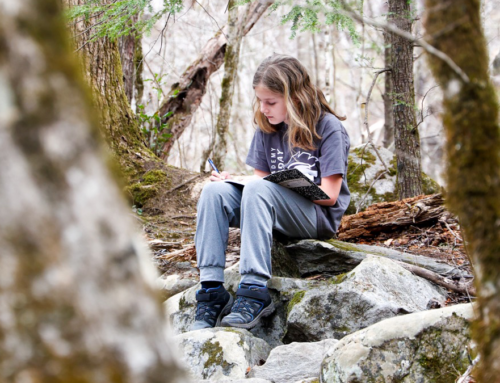Smokies to Schoolyard Connection – Outdoor Lessons for Educators
“To experience the world in memorable ways, we need to treat perception as an active process of recognizing, probing, questioning, comparing, opinions, and feeling.” – Ed Cooke, The Guardian
Too often, students are told that there is only one correct answer to a question, and that there is no time for wonder in the classroom. We at Tremont Institute are here to help you break this cycle and bring wonder back into your classroom through something as simple as observation.
In his article from The Guardian, “The Importance of Observation,” Ed Cooke implores, “[W]e need to appreciate that our senses are not designed to record the world, but instead to make sense of it.” The following activity can spark curiosity into your students’ minds, awaken their sense of wonder, and engage them in critical thinking about the world around them.
INVITE students to hone their observation skills by taking a closer look into the world around them. Begin class by covering a table with different nature themed items. These objects can include: mounds of dirt, feathers, leaves, pictures of sunsets or sunrises, plants, etc. Engage your students by giving them an opportunity to choose an object to take back to their desks. Modeling is key in observation exercises, so be sure to model best observation practices for your class. You can do this by picking an object for yourself, thinking aloud as you engage your senses in examining your object, and then writing what you notice and what you wonder about it on the board. Next, have your students practice by creating a classwide list on the board with what they notice and wonder about the different objects they’ve chosen.
EXPLORE Have students put their objects to the side of their desks, and pull out another container of different items that are frequently seen in nature, but that your students may not have fully paid attention to. These types of objects can include: the fruit from an osage orange tree, sycamore seed pod, buckeye nut, quarts, clay, bones of an animal, bees nest, wasp nest, sweetgum seed, etc. Let your students explore these new and interesting items and choose a new item to take back to their desks. Then, create a new class list, together, with what your students notice and what they wonder about these new objects.
WONDER Model comparing and contrasting of the two objects for your students. Think aloud as you examine both of your items, side-by-side. Then, ask your students to consider the following: Is there a difference between the first and second observations that they made? Was there a certain object from either selection that piqued the curiosity of the whole class? Students may start to see patterns within their findings as they compare and contrast their objects. Next, facilitate a journal entry where each student picks the object that sparked the most curiosity and then observe it even deeper. Have each student draw their item in their journals, and ask them to include descriptive words and quantifiable information (such as the number of points, size of object, etc.) that could help them identify it among the rest of the items.
CREATE Encourage your students to take the curiosity that they’ve harnessed in this classroom activity back home with them. Give a journal prompt as a take-home assignment that allows students to see the changes and patterns present in their backyards or in a nearby park. Ask students to connect with the natural world by picking a part of nature that rejuvenates them. They can do this by paying close attention to an aspect of nature that they have seen many times before and observing how it works and interacts with the world, or through investigating something completely new. Instruct your class to draw their object or piece of nature in their journals, and that they should including quantifiable and descriptive words, just as they did in class. Encourage your students to ask questions as they observe and to write them in their journals, as well.
SHARE The next day, give your students a chance to share their journal entries with one another by sharing with a shoulder buddy, breaking them into small groups, or lay out all of the journals on the floor and let them share their observations with the whole class. Giving your students the ability to teach their peers about their observations will give them a chance to take ownership of their curiosity and research, and it will allow them to stay fully engaged while they are learning the fundamentals of careful observation and thought. Share photos or scans of your students’ journal entries with Tremont so that we can see what nature-based observations are being made outside of Great Smoky Mountains National Park!




![A Deep Dive Into Wetlands [Free Lesson Plan]](https://gsmit.org/wp-content/uploads/2024/02/madeline-blog-cover-500x383.png)
![Are You a Math and Science Person or a History and English Person? [Free Lesson Plan]](https://gsmit.org/wp-content/uploads/2024/01/Girls-in-Science-Erin-Rosolina-3-1-500x383.jpg)

